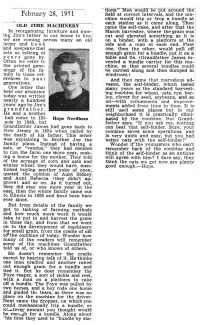In reorganizing furniture and moving Jim's father to our house to live, we are coming across many an old letter and book and keepsake that sets us talking of years gone by. Often we refer to the printed geneology of the family to trace references to past generations.
One letter that held our attention today ws written nearly a hundred years ago by Jim's grandfather. He and a brother had come to Illinois in 1849, but Grandfather James had gone back to New Jersey in 1854 when called by the death of his father. This letter was explaining to Brother Joe the family plans. Instead of having a sale, or "vendue," they had decided to run the farm one more year, making a home for the mother. They told of the acreage of corn and oats and winter wheat they would have, mentioned buying another yoke of oxen, quoted the opinion of Aunt Sidney and Aunt Rebecca (they didn't approve) and so on. As it turned out, they did stay one more year in the east, then the whole family came out to Illinois in 1855 and have been here ever since.
But from details of the family we got to talking of farming methods and how much more work it would take to put in and harvest the grain in those days, and from that we went on to the development of machinery for small grain, from the cradle of old to the combine of today. Wonder how many of the readers will remember some of the machines Grandfather told us of, or who knows of others.
He doesn't remember the cradle except by hearing talk of it. He thinks one man cradled and another raked out enough grain for a bundle and tied it. But he does remember the Foye reaper, a sort of sickle and reel, with a man on a platform to rake off a bundle. The Foye was pulled by two horses, and a boy rode one horse and guided the team, as there was no place on the machine for the driver. Next came the dropper, on which you could mechanically trip a bundle, or whatever amount you thought would be enough for a bundle. Along about this time they used to "bundle by stations." Men would be put around the field at correct intervals, and the machine would trip or drop a bundle at each station as it came along. Then came the self-rake, and after that the March harvester, where the grain was cut and elevated something as it is on a binder, with a platform at the side and a man at each end. First one, then the other, would pull off enough grain for a bundle, put it on a table and tie. (Grandfather James invented a bundle carrier for this machine, so that several bundles could be carried along and then dumped in windrows.)
And then came that marvelous advance, the self-binder, which lasted many years as the standard harvesting machine for wheat, oats, rye, barley, clover for seed, soybeans, and so on -- with refinements and improvements added from time to time. It is still used some places but in our neighborhood it is practically eliminated by the combine. But Granfather says, "If you ask me, nothing can beat that self-binder. Sure, your combine saves some operations, and is very quick and easy, but you had better oats with the self-binder!"
Wonder if the youngsters who can't remember back of the combine and think of the self-binder as an antique will agree with him? I dare say, they think the oats we get now are plenty good enough. -- Hope.

